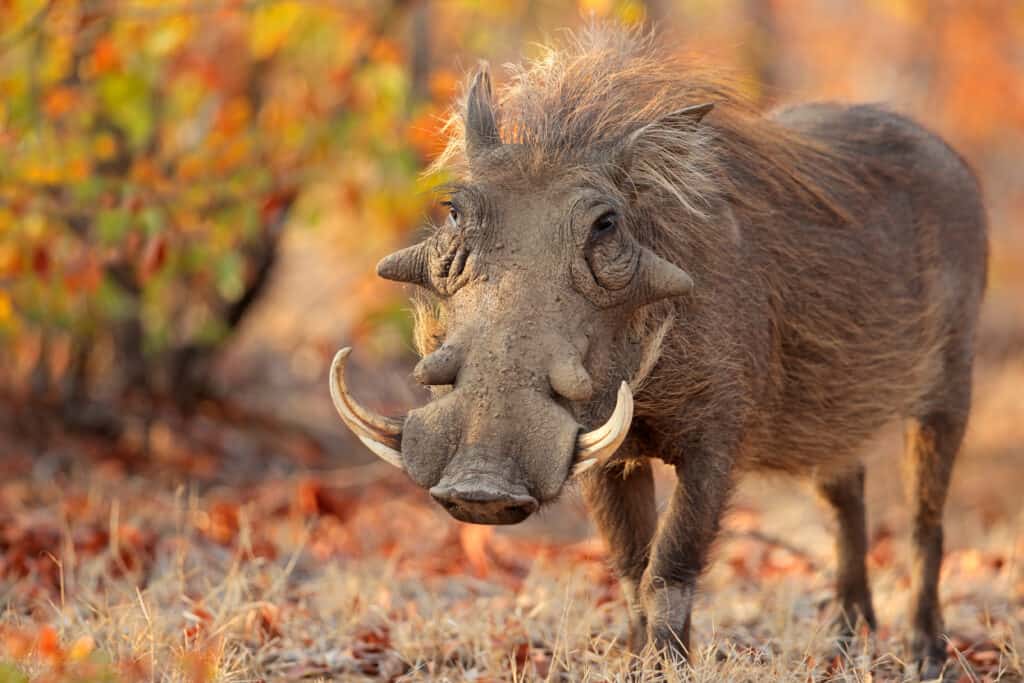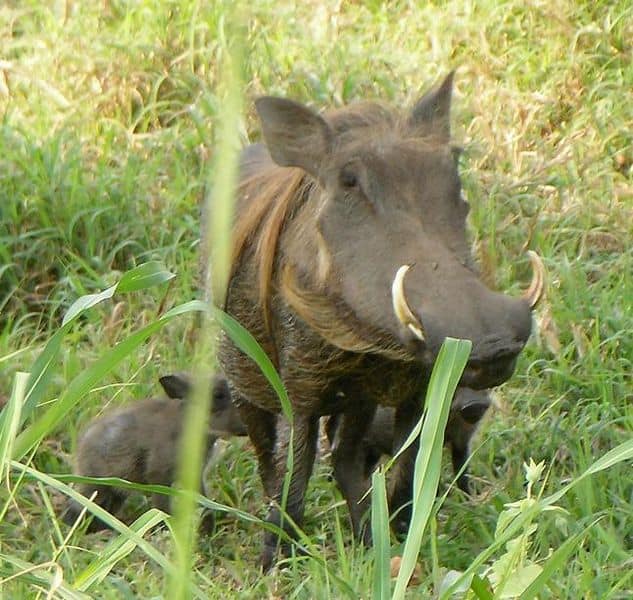A warthog is a medium-sized wild member of the pig family. It has a stocky body covered with coarse hair and two pairs of tusks.
Watch The Video Below to See Warthog Freeze When Approached
Warthogs are found in sub-Saharan Africa, mainly in savannas and grasslands. Their tough hide allows them to survive in places where few other animals can.
Warthogs are omnivores, eating grasses, small mammals, birds, and roots. They use their tusks to dig up tubers and bulbs from the soil.
When threatened by predators such as lions or leopards, warthogs will run away as fast as possible. Warthogs will defend themselves, if no escape route is available, by charging at their attackers with their tusks bared.

Warthogs use their tusks to dig up tubers and bulbs from the soil.
©nwdph/Shutterstock.com
In this video, however, the warthog freezes when the two lions charge at it. As it cannot run or defend itself, the lions have a better opportunity to feed on it mercilessly.
Adaptations of a Warthog

Warthogs have a distinctive appearance with long snouts, short legs, and bulky bodies.
©EcoPrint/Shutterstock.com
Warthogs have a distinctive appearance with long snouts, short legs, and bulky bodies. They carry their heads low to the ground when they walk or run. As a result, they can see predators approaching from behind as they search for roots, bulbs, tubers, and fallen fruit.
Warthogs have poor eyesight but excellent hearing and smell. They use their sense of smell to find food, which may be buried under the ground or hidden in piles of leaves. They can dig up roots using their powerful front legs. They also use their tusks to dig into the ground when they cannot reach down far enough with their legs.
The warthog’s tough skin protects it from many predators, including lions and hyenas. It also uses its sharp tusks to defend itself against other animals when it feels threatened.
Warthogs live in groups called sounders that typically consist of one male with up to 10 young females. Occasionally, two or three other males may join a sounder temporarily so they can be protected from predators as they travel through unfamiliar territory looking for food or water.
How to Repel Warthogs From Your Garden

Warthogs are usually shy and will run away from any human presence.
©Brian Dell, Public domain, via Wikimedia Commons – License
Warthogs are not the most aggressive of animals. They are usually shy and will run away from any human presence. However, they can be very territorial and may attack if they feel threatened.
Here are some things you can do to keep warthogs out of your garden:
Keep Compost Away
Your compost heap can be a source of food for warthogs. Keep it far away from the house. If a warthog finds an easy meal, it will come back again and again.
Don’t Leave Food Remains Outside
As mentioned earlier, food remains can attract warthogs to your compound. So don’t leave any edible scraps lying around outside.
Fence Your Garden
Put a fence around your veggie patch if you have one, or grow your plants in containers that can be moved inside at night.
Hang Feeders From Trees
If you want to feed birds but don’t want to attract warthogs, hang feeders from trees rather than putting them on the ground.
Get Rid of Holes or Gaps
Warthogs like to dig, so ensure there are no holes or gaps under sheds or other outbuildings where they could get under the fence and into your property.
The photo featured at the top of this post is © Jixin YU/Shutterstock.com
Thank you for reading! Have some feedback for us? Contact the AZ Animals editorial team.






